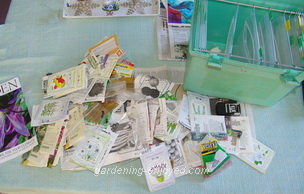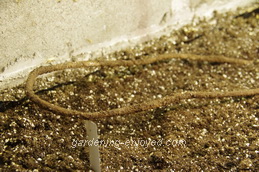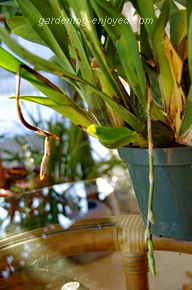| Back to Back Issues Page |
 |
|
Dallying In The Dirt, Issue #157 --- It's time to check the seeding heat cable before we need it. February 15, 2014 |

Winter continues!! Today we have finally squeaked above the freezing point for the first time in a long time and the sun shone. I wanted to stay outside and prune the Grapes or the Crab Apple but the snow was too deep to get to them. My large Loblaw’s container that lights up and changes colour is staying white because the solar collector is somewhere, way under the snow. The main chore this week is to empty my seed storage box and sort out what I have. Many types of seeds will stay viable for years. Tomato seeds that are ten years old seem to germinate as well as fresh ones, a bit of nature that fascinates and mystifies me. Parsnip seed that is two years old is essentially useless. Explain that difference if you can? To keep my germination success rate, as high as possible, it is my habit to toss out any seed, with a few rare
exceptions, that is two years old. All of my seed packets get date stamped when I receive them and this week I will toss any that have a 2012 stamp on them. When that is done I will finish my orders of new seeds for this year. The Begonias have germinated very well but the Onions are really the first items in the long list of seeds that will come to the germination table over the next few weeks. Onion seeds have quite a long viability so I may sow some old ones if I haven’t got around to ordering the new ones soon enough.  There seems to be very little to actually do but there is this feeling of impending craziness. It’s a bit early to plant Tuberous Begonias or to prune the Hibiscuswhich is in full flower but we want to get started because we know that in a couple of weeks there will be too many things to do. Making sure that we have been to the garden centre and purchased sufficient soil to start those seeds and the package of starter fertilizer to transplant them with, is a pleasant way to keep gardening. I have to try and avoid the racks of new Begonia tubers and other such delights; where would I grow them? Friends are telling me about interesting varieties that they have discovered. One of the main secrets to success when starting seeds is the soil warm enough. I need to check and make
sure my heating cable is working before I need it. It’s relatively easy to replace when the propagating bed is empty but I don’t want to discover several trays of seeds, rotting in cold soil, and then have to replant them all after I have moved them and replaced that cable. A little early preparation can avert later bigger disasters and that’s another of those lessons that I have learned the hard way.
There seems to be very little to actually do but there is this feeling of impending craziness. It’s a bit early to plant Tuberous Begonias or to prune the Hibiscuswhich is in full flower but we want to get started because we know that in a couple of weeks there will be too many things to do. Making sure that we have been to the garden centre and purchased sufficient soil to start those seeds and the package of starter fertilizer to transplant them with, is a pleasant way to keep gardening. I have to try and avoid the racks of new Begonia tubers and other such delights; where would I grow them? Friends are telling me about interesting varieties that they have discovered. One of the main secrets to success when starting seeds is the soil warm enough. I need to check and make
sure my heating cable is working before I need it. It’s relatively easy to replace when the propagating bed is empty but I don’t want to discover several trays of seeds, rotting in cold soil, and then have to replant them all after I have moved them and replaced that cable. A little early preparation can avert later bigger disasters and that’s another of those lessons that I have learned the hard way.Now it’s time to answer a few of my reader’s questions. Don’t forget to check the front page of the Website for frequent short ideas for current gardening activities. Sofie Asks Regarding transplanting of Phalaenopsis Orchids; no one ever talks about the roots that stick out all over the place and trying to get them back in the pot after transplanting or refreshing the growing medium. I have 4 or 5 smaller orchids that
are growing sideways for some reason. I would like to straighten them but how do I do that with the roots - there is no way that they will fit in the same pot without cutting them. Can the roots be cut back or can some be removed to accommodate the current sized pots and should some of these roots be left exposed? |
| Back to Back Issues Page |
 In the solarium where the
In the solarium where the